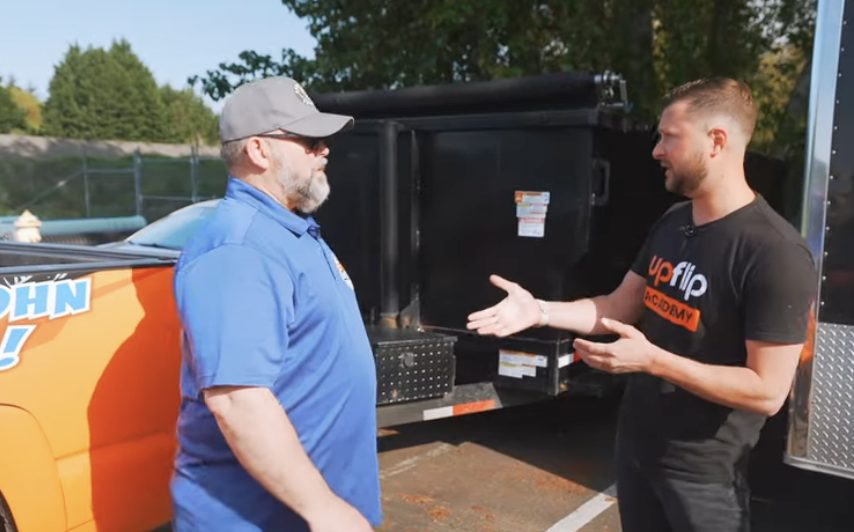I was watching UpFlip’s new video, and it showed me how, when his wife was laid off while five months pregnant with their sixth child, panic set in. They lost a six-figure income overnight. Little did he know that late-night YouTube rabbit holes would lead them to a business generating $20,000 to $25,000 per month, while they still worked their day jobs.
The junk removal industry isn’t glamorous, but it’s incredibly profitable with minimal startup costs. Their journey began with a $750 used truck and a $1,400 hay trailer. Today, they are debt-free, with a thriving business that serves as both an additional income source and a legacy for their children.
Getting Started: Minimal Investment, Maximum Return
The beauty of junk removal is its simplicity. After being laid off, they realized you don’t need much to begin—just a truck and a hand truck at minimum. They started with an old Chevy short-bed truck from a garage sale and a small hay trailer, investing a total of less than $2,500.
Their first job involved removing a massive cottonwood tree for an elderly widow. While he had no idea what he was doing, he quoted $2,000 (much less than the $6,000 she had been previously mentioned), called his father-in-law for help, and spent two weeks breaking it down into manageable pieces. It wasn’t the most profitable job, but it taught valuable lessons about service and customer relationships.
Building a Customer Base Without Expensive Advertising
The most surprising lesson they’ve learned is that expensive advertising doesn’t work in this business. Despite being laid off and trying to grow quickly, they wasted over $60,000 on Google Ads, radio spots, and SEO services with virtually no return on investment.
What actually works is networking and word-of-mouth referrals. A chance conversation between his wife and a real estate agent led them to join a local networking group called IgniteU. To this day, about 70% of their business comes directly or indirectly from connections made through this group.
Other effective strategies include:
-
Posting on community Facebook pages
-
Building relationships with complementary businesses (like pool stores for hot tub removal referrals)
-
Asking satisfied customers for Google reviews
-
Using their truck as a rolling billboard ($5,000 investment that quickly paid for itself)
The simple act of responding to emails and phone calls promptly has won them business over their competitors. Many customers tell them, “You’re the only one who called back.”
The Double-Profit Secret: Metal Recycling
One of the most profitable aspects of junk removal is separating recyclable materials. We get paid twice for certain items—once by the customer to haul it away and again at the recycling center.
Copper currently sells for about $2.61 per pound. When we find valuable metals, we separate them and save until we have enough to make a recycling trip worthwhile. This creates a win-win situation: customers appreciate our environmental responsibility, landfills last longer, and we generate an extra profit.
We’ve even found valuable items during cleanouts. Once, we discovered a brand-new book magnification machine worth $3,000 in a barn cleanout and sold it for $700—making a pure profit on a job we were already being paid to do.
Pricing for Profit: The $200/Hour Rule
My golden rule is simple: I don’t leave the house unless I’m making $200 an hour. From the time I leave home until I return, that’s my minimum target.
We price by volume, using our 16-cubic-yard trailer as a reference point. A full load costs $875, half a load is $440, and so on. Unlike competitors who insist on in-person quotes, we ask customers to send photos so we can provide estimates before arriving.
The most profitable service? Hot tub removal. We charge $675 for a four-person hot tub and up to $1,000 for larger ones. Most hot tub removals take only 30-45 minutes, making them extremely profitable.
Balancing Family, Full-Time Jobs, and Business
People often ask why they haven’t quit their day jobs yet. The answer involves both practical considerations and long-term vision. After being laid off previously, they know the importance of steady income. They have six children with six sets of activities, a mortgage, and other typical expenses. Their careers provide pensions for retirement security.
He works four 10-hour shifts at his day job, starting at noon. Mornings from 9–11 AM are for junk removal jobs, then Saturdays are full business days. Sundays are reserved for family. His wife handles all the administrative work, and they hired a CPA early on to manage bookkeeping.
The business isn’t just about immediate income—they’re building an asset to pass down to their children. They reinvest most profits back into equipment and growth rather than taking large distributions.
The most rewarding aspect has been spending time with their kids on jobs. Those truck rides create natural opportunities for meaningful conversations that might not happen otherwise.
Looking Forward: Sustainable Growth
Their biggest month brought in nearly $50,000, but they average $20,000–$25,000 monthly with 60–70% profit margins due to low overhead. They’re focusing on adding commercial accounts to smooth out seasonal fluctuations—April through September are busy, while winter months slow down.
After being laid off, he’s even more motivated and is planning to transition away from his physical day job in 2–3 years to run the business full-time. They’ve intentionally avoided debt so far, but recognize that strategic financing for equipment may become necessary as they grow.
For anyone considering this business, the advice is simple: just start. The fear is just a roadblock. Once you begin doing the work, the fear disappears. Mitigate risk by starting debt-free if possible, but don’t let “what ifs” stop you from building something valuable.
Frequently Asked Questions
Q: I was recently laid off—can I realistically start a junk removal business with limited experience?
Absolutely. Many people who have been laid off find junk removal to be a quick and accessible business to start. With minimal startup costs and flexible hours, it’s a great option to generate income while transitioning careers.
Q: How much does it cost to start a junk removal business?
You can start with as little as $2,000 to $3,000 if you already have a truck. Our initial investment was a $750 used truck and a $1,400 trailer. The most important equipment is a truck and a hand truck. As you grow, investing in a dump trailer ($10,000-$12,000) will significantly increase efficiency.
Q: What services are most profitable in junk removal?
Hot tub removal is highly profitable, with prices ranging from $675 for a four-person hot tub to $1,000 for larger ones, typically taking only 30-45 minutes. House cleanouts are also very profitable, especially when combined with metal recycling for additional revenue.
Q: How do you find customers without spending a fortune on advertising?
Networking groups, community Facebook pages, and word-of-mouth referrals are the most effective ways to find customers. Building relationships with real estate agents, property managers, and complementary businesses (like pool stores) can create steady referral streams. Vehicle wraps also serve as an effective form of mobile advertising.
Q: Can this really be done as a side business while working full-time?
Absolutely. We’ve built a $20,000-$25,000 monthly business while both maintaining full-time careers. I work four 10-hour shifts at my day job and schedule junk removal jobs in the mornings and on Saturdays. With good time management and family support, it’s entirely possible to run this as a profitable side hustle.
Q: What’s the best way to handle pricing in this business?
We price by volume, using our trailer as a reference point ($875 for a full 16-cubic-yard load). Unlike our competitors, who only provide in-person quotes, we ask customers to send photos for preliminary estimates. When customers try to negotiate, our policy is simple: “The price is the price.” This approach maintains profitability while providing customers with transparency.







